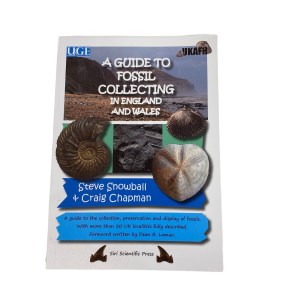The fields around Ilminster in Somerset are famed for their Jurassic fossils from the Upper Lias Beacon Limestone Formation (formerly, the so-called ‘Junction Bed’). In particular, ammonites are both sought after and common. After ploughing, these can often be found in some numbers at this location, just lying on the surface of the fields.

 DIRECTIONS
DIRECTIONS
♦ Location 1: The fields at Kingstone are opposite the church of St John & All Saints at Kingstone village. (The postcode is TA19 0NS)
♦ Park just outside the church in the lay-by/driveway, ensuring that access to properties to the rear of the drive is not blocked.
♦ Opposite the church is a public footpath that runs right across a field towards the village of Dowlish Wake. Walking across this footpath reveals the ammonites to either side, within the furrows of the ploughed field
♦ Ref: 50.914493, -2.8842223
♦ Location 2: Another field can be accessed via a footpath, which starts between the houses on the south side of Long Close in Kingstone village (at postcode TA19 0EP). It goes around a wheat field and then crosses three pasture fields, before going along the edge of another wheat field and on into Moolham Lane. Again, given the right conditions and time of year, ammonites can be found in the ploughed earth along this route.
♦ Ref: 50.918342, -2.9084855
PROFILE INFO
FIND FREQUENCY: ♦♦♦♦♦ – The fields around this area are highly productive, especially after ploughing. In these circumstances, you should easily find good specimens and they are plentiful.
CHILDREN: ♦♦♦♦♦ – This is an excellent site for children, as they can simply pick up some wonderful ammonites without the dangers of cliffs or the sea. It also makes a wonderful family walk.
ACCESS: ♦♦♦♦♦ – Access is very easy, with parking right next to the fields and public footpaths. However, the best time to visit is after the fields have been freshly ploughed.
TYPE: – Fossils are found in the farm fields, which are ploughed annually. They come to the surface and can be picked up easily. There are public footpaths in and around the fields.
FOSSIL HUNTING
The Moolham Lane end of the footpath is very fossiliferous and the edges of this huge field are also worthy of consideration. It is certainly best to collect after ploughing, when fresh material is brought to the surface and when crops are not actively growing. Keep to the footpaths and do not tread over the fields if prior permission has not been granted to do so.
The ammonites are mostly of Dactylioceras sp, Harpoceras sp and Hildoceras sp, and are strewn over the entire surface of the field. Most are complete, although the largest specimens are often broken due to modern ploughing methods but it is possible to find complete ones with careful searching. The number of specimens obtainable at the site is quite large, but we do urge sensible collecting, allowing others to also benefit from the location.
Other fields in the area also lie above the Lias, but locating them is not easy, especially if they are under crops.

GEOLOGY
The fossils are of Lower Jurassic (Pliensbachian to Toarcian) age, approximately 190 to 183myrs old. This is the Upper Lias the Beacon Limestone Formation (formerly, the ‘Junction Bed’). The Beacon Limestone Formation in South Somerset is comprised of the Marlstone Rock Member, overlain by the Barrington Beds Member. It is the latter which yields the fossils of the Beacon Limestone at this location. The top of the limestone is also the base of the Bridport Sand Formation.


EQUIPMENT
You do not need any tools here. Ammonites can simply be picked up from the fields, ploughed out from the ground. However, you will need something to put them on, and sensible footwear is recommended, especially when the fields have been ploughed.
It is quite usual to find ammonites with just one side well preserved. Limestone matrix is commonly still attached to the other side. This could be partially removed with an air pen, or a Dremel engraver and fossil preparation tips or alternatively left alone. No preservative will be required.
SAFETY
The fields provide a safe and easy way to collect fossils. There are no hazards at this site.
ACCESS RIGHTS
There are no restrictions at this site, and there is free access from the public footpaths around the fields. However, ensure that the fields are not under crops, although the footpath will not interfere with these, as long as you keep to the path. You’ll soon spot the ammonites, but avoid any growing crops.
It is important to follow our ‘Code of Conduct’ when collecting fossils or visiting any site. Please also read our ‘Terms and Conditions‘
LINKS
♦ Buy Fossils, Crystals, Tools
♦ Location Discussions
♦ Deposits Magazine
♦ Join Fossil Hunts
♦ UK Fossils Network

























